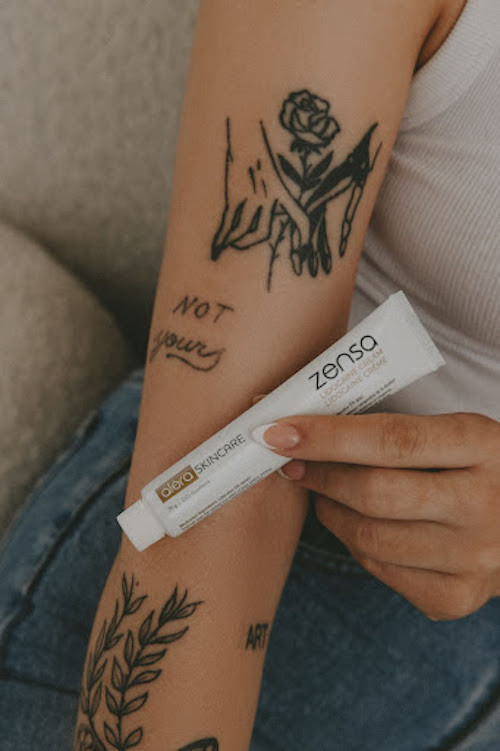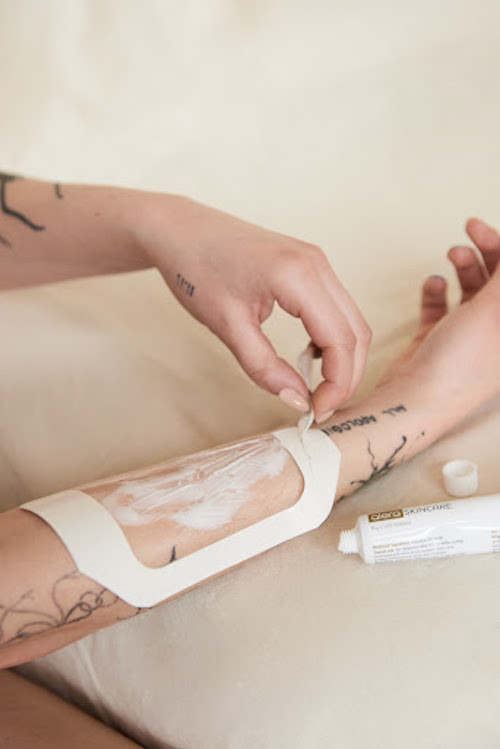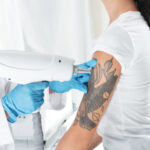Do Inner Elbow Tattoos Hurt? Absolutely, getting a tattoo on your inner elbow can be quite painful, but understanding why and how to manage it can make the experience more bearable, and at tattooat.com, we provide all the insights you need. Factors like nerve endings, thin skin, and bone proximity contribute to the intensity, but preparation and aftercare can significantly influence your comfort levels. Explore diverse tattoo styles and discover pain management strategies at tattooat.com, enhancing your body art journey with expert guidance on tattoo aftercare, tattoo placement, and pain relief methods.
1. Why Inner Elbow Tattoos Tend to Hurt More
Inner elbow tattoos are notorious for their high pain levels. The reason lies in the unique anatomy of the area.
Nerve Density
The inner elbow, also known as the elbow ditch, is home to a high concentration of nerve endings. This means the area is highly sensitive, and any stimulation, such as a tattoo needle, can result in significant discomfort. According to studies in pain perception, areas with more nerve endings tend to register pain more intensely.
Thin Skin
The skin in the inner elbow is thinner compared to other body parts. This lack of cushioning means the tattoo needle is closer to the nerves and bone, increasing the sensation of pain.
Bone Proximity
The bones in the elbow are close to the surface, leaving little fat or muscle to act as a buffer. This proximity amplifies the vibrations and pressure from the tattoo machine, making the process more painful.
Major Nerves
Two of the three major nerves in your arm—the median and ulnar nerves—pass through the inner elbow. These nerves are responsible for sensation and movement in the forearm and hand. Tattooing in this area can irritate these nerves, leading to increased pain.
 Inner Elbow Tattoo
Inner Elbow Tattoo
2. The Tattoo Pain Scale: Where Does the Inner Elbow Rank?
The tattoo pain scale is a subjective measure, but it helps to provide a general idea of the pain level associated with different tattoo placements.
Understanding the Pain Scale
Typically, the tattoo pain scale ranges from 1 to 10, where 1 is minimal pain and 10 is the most excruciating pain imaginable. Different areas of the body will rank differently on this scale.
Inner Elbow Ranking
The inner elbow usually ranks high on the pain scale, often between 7 and 9. This high ranking is due to the factors mentioned earlier: nerve density, thin skin, and bone proximity. Most people who have tattoos in this area report a sharp, burning sensation.
Comparative Pain Levels
Compared to other common tattoo locations:
- Less Painful: Outer forearm, outer thigh, upper back
- Moderately Painful: Stomach, calf, inner bicep
- More Painful: Rib cage, spine, knee ditch
Individual Variation
It’s important to remember that pain tolerance varies from person to person. Factors such as stress level, overall health, and even mood can affect how much pain you experience.
3. Factors Influencing Tattoo Pain
Several factors can influence how much pain you feel during a tattoo session. Knowing these can help you prepare better and potentially reduce discomfort.
Personal Pain Tolerance
Everyone experiences pain differently. What one person finds unbearable, another might find manageable. Your personal pain tolerance is a significant factor in how much an inner elbow tattoo will hurt.
Tattoo Size and Complexity
Larger and more complex tattoos require more time and effort, which means prolonged exposure to the needle. This can lead to increased pain and fatigue. Simpler, smaller designs will generally be less painful.
Artist’s Skill Level
An experienced tattoo artist can make a big difference in your comfort level. Skilled artists are often more efficient and precise, reducing the amount of trauma to the skin. They also know how to adjust their technique to minimize pain.
Mental and Emotional State
Stress, anxiety, and fear can heighten your perception of pain. Being relaxed and mentally prepared can help you manage the discomfort more effectively. Some people find it helpful to meditate or listen to calming music during the session.
Physical Health
Your overall health can also play a role. Being well-rested, hydrated, and having eaten a good meal can help your body cope with the stress of getting a tattoo. Avoid alcohol and caffeine before your appointment, as these can increase anxiety and sensitivity.
4. Preparing for an Inner Elbow Tattoo
Proper preparation can significantly reduce the pain and discomfort associated with an inner elbow tattoo.
Mental Preparation
Understand what to expect. Research the process, talk to people who have tattoos in similar locations, and mentally prepare yourself for the pain. Visualizing a successful outcome can also be helpful.
Physical Preparation
- Get Enough Sleep: Being well-rested can improve your pain tolerance.
- Stay Hydrated: Dehydration can make your skin more sensitive.
- Eat a Good Meal: A balanced meal can help stabilize your blood sugar and keep you from feeling lightheaded.
- Avoid Alcohol and Caffeine: These substances can increase anxiety and sensitivity.
Skin Preparation
- Moisturize: Keep the skin in the inner elbow well-moisturized in the days leading up to your appointment.
- Exfoliate: Gently exfoliate the area to remove dead skin cells.
- Shave: If necessary, shave the area to ensure the tattoo artist has a clean canvas.
Choosing the Right Time
Consider scheduling your appointment at a time when you are less likely to be stressed or rushed. This can help you stay relaxed and focused during the session.
5. Pain Relief Options
There are several options for managing pain during an inner elbow tattoo session.
Tattoo Numbing Creams
Topical numbing creams containing lidocaine can be applied to the skin before the tattoo session to reduce pain. These creams work by blocking nerve signals in the area, providing temporary relief. Zensa Numbing Cream, available at tattooat.com, contains 5% lidocaine and does not affect ink settling.
During the Tattoo Session
- Breathing Techniques: Deep, controlled breathing can help you relax and manage pain.
- Distraction: Listening to music, watching a movie, or talking to the artist can help take your mind off the pain.
- Breaks: Don’t hesitate to ask for breaks if you need them. Taking a few minutes to stretch, breathe, and refocus can make a big difference.
Aftercare
Proper aftercare is essential for minimizing pain and promoting healing.
- Keep the Area Clean: Gently wash the tattooed area with mild soap and water.
- Moisturize: Apply a tattoo-friendly moisturizer to keep the skin hydrated.
- Avoid Irritants: Stay away from tight clothing, harsh chemicals, and excessive sun exposure.
- Follow Artist’s Instructions: Follow your tattoo artist’s specific aftercare instructions to ensure proper healing and minimize discomfort.
 Applying Skincare
Applying Skincare
6. Coping Strategies During the Tattoo Session
Staying calm and focused during the tattoo session can help manage pain and anxiety.
Communicate with Your Artist
Let your tattoo artist know how you’re feeling. They can adjust their technique or take breaks as needed.
Relaxation Techniques
Practice relaxation techniques such as deep breathing, progressive muscle relaxation, or visualization.
Mindfulness
Focus on the present moment and try to observe your thoughts and feelings without judgment. This can help you stay grounded and reduce anxiety.
Positive Self-Talk
Remind yourself that the pain is temporary and that you are strong enough to handle it.
Stay Hydrated and Fueled
Keep water and snacks on hand to maintain your energy levels and stay hydrated.
7. Choosing the Right Tattoo Design and Artist
Selecting the right design and artist can influence your overall experience, including pain levels.
Design Considerations
- Simplicity: Simpler designs with fewer lines and shading may be less painful than complex, intricate designs.
- Placement within the Area: Some areas of the inner elbow may be more sensitive than others. Discuss placement options with your artist.
- Size: Smaller tattoos will generally be less painful than larger ones.
Artist Selection
- Experience: Choose an artist with experience tattooing the inner elbow. They will be familiar with the challenges of the area and know how to minimize pain.
- Technique: Look for an artist who uses smooth, efficient techniques. This can reduce the amount of trauma to the skin.
- Communication: Find an artist who is willing to listen to your concerns and work with you to create a comfortable experience.
At tattooat.com, we offer a curated list of talented tattoo artists and studios to help you find the perfect match for your needs.
8. The Healing Process and Aftercare for Inner Elbow Tattoos
Proper aftercare is crucial for minimizing pain and preventing infection after getting an inner elbow tattoo.
Immediate Aftercare
- Keep the Bandage On: Leave the bandage on for the amount of time recommended by your artist (usually a few hours).
- Gently Wash: After removing the bandage, gently wash the tattooed area with mild soap and water. Pat dry with a clean towel.
- Apply Moisturizer: Apply a thin layer of tattoo-friendly moisturizer to keep the skin hydrated.
Ongoing Care
- Keep it Clean: Wash the tattoo twice a day with mild soap and water.
- Moisturize Regularly: Apply moisturizer several times a day to prevent dryness and itching.
- Avoid Sun Exposure: Protect the tattoo from direct sunlight by wearing loose clothing or using sunscreen.
- Don’t Pick or Scratch: Avoid picking or scratching the tattoo, as this can lead to infection and scarring.
- Stay Hydrated: Drink plenty of water to keep your skin hydrated from the inside out.
Signs of Infection
Watch for signs of infection, such as:
- Excessive Redness
- Swelling
- Pus or Drainage
- Fever
- Increased Pain
If you notice any of these symptoms, contact your tattoo artist or a healthcare professional immediately.
 Tattoo Numbing Cream
Tattoo Numbing Cream
9. Alternative Tattoo Placements with Less Pain
If you’re concerned about the pain of an inner elbow tattoo, consider these alternative placements that are generally less painful.
Outer Forearm
The outer forearm is one of the least painful spots to get a tattoo. The area is fairly fleshy with few nerve endings.
Outer Thigh
The outer thigh has more fat and muscle, which helps to cushion the pain.
Upper Back
The upper back has thicker skin and fewer nerve endings, making it a less painful option.
Shoulder
The shoulder area has some muscle and fat, which can help to minimize pain.
Calf
The calf is generally less painful than the shin, as it has more muscle and less bone proximity.
10. Real Experiences: What People Say About Inner Elbow Tattoo Pain
Hearing from others who have experienced inner elbow tattoos can provide valuable insights.
Common Descriptions
- Sharp Pain: Many people describe the pain as sharp and intense, similar to a burning or scratching sensation.
- Radiating Pain: Some report that the pain radiates down the arm or up towards the shoulder.
- Uncomfortable Vibration: The vibration of the tattoo machine can be particularly uncomfortable in the inner elbow due to the bone proximity.
Personal Accounts
“I have tattoos all over my body, and the inner elbow was by far the most painful. It felt like my bones were vibrating!” – Sarah
“I used numbing cream, and it helped a lot. I wouldn’t have been able to get through it without it.” – Mark
“The pain wasn’t as bad as I expected, but it was definitely intense. Taking breaks and focusing on my breathing helped me get through it.” – Emily
Expert Opinions
According to Portland State University’s Art Department, in July 2025, the inner elbow ranks among the most sensitive areas for tattooing due to its nerve density and thin skin.
FAQ About Inner Elbow Tattoos and Pain
1. How long does an inner elbow tattoo take?
The duration depends on the size and complexity of the design. A small, simple tattoo may take an hour or two, while a larger, more intricate piece could take several hours or multiple sessions.
2. Can I use numbing cream for an inner elbow tattoo?
Yes, numbing cream can be used to reduce pain. Apply it 30-45 minutes before the session and cover with saran wrap to enhance absorption.
3. What is the best aftercare routine for an inner elbow tattoo?
Keep the area clean and moisturized. Avoid sun exposure, tight clothing, and picking or scratching the tattoo.
4. How much does an inner elbow tattoo cost?
The cost varies depending on the artist, studio, and complexity of the design. Prices can range from $100 to $500 or more.
5. Is it safe to get a tattoo on my inner elbow?
Yes, as long as you choose a reputable artist and follow proper aftercare procedures.
6. What are the risks associated with inner elbow tattoos?
Risks include infection, allergic reactions, and scarring. Choose a licensed and experienced artist to minimize these risks.
7. How can I find a good tattoo artist for an inner elbow tattoo?
Check online reviews, ask for recommendations, and look at the artist’s portfolio. Ensure they have experience with inner elbow tattoos.
8. How do I know if my inner elbow tattoo is infected?
Signs of infection include excessive redness, swelling, pus, fever, and increased pain. Contact your artist or a healthcare professional if you suspect an infection.
9. What should I wear to my inner elbow tattoo appointment?
Wear loose, comfortable clothing that allows easy access to the inner elbow area.
10. Can I exercise after getting an inner elbow tattoo?
Avoid strenuous exercise for the first few days after getting the tattoo. Light activities are fine, but be sure to keep the area clean and protected.
Getting an inner elbow tattoo can be a rewarding experience, allowing you to express your individuality and artistic tastes. While the pain can be intense, understanding the factors involved, preparing properly, and following proper aftercare can make the process more manageable. At tattooat.com, we’re dedicated to providing you with the knowledge and resources you need to make informed decisions about your body art journey.
Ready to explore stunning tattoo designs, find talented artists, and learn more about tattoo aftercare? Visit tattooat.com today and discover the perfect inspiration and guidance for your next tattoo adventure!
Address: 1825 SW Broadway, Portland, OR 97201, United States
Phone: +1 (503) 725-3000
Website: tattooat.com
